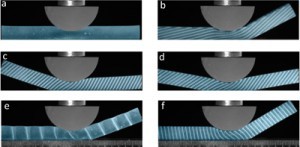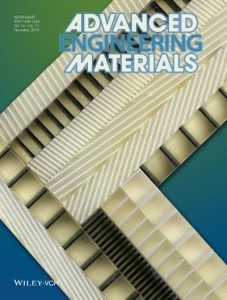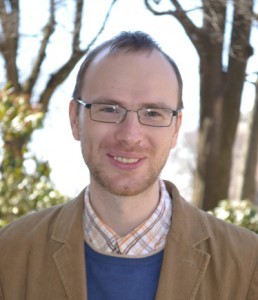The future is just around the corner
3-D Printing Technology has opened new possibilities for theoretician, Asst. Prof. Stephan Rudykh, to test his theoretical models of active material properties
Imagine yourself boarding a futuristic morphing airplane made of materials that can repair themselves. While on board, have a look at the photos that the lightweight soft robot took from a narrow space on Mars, where other devices could not reach. Enjoy your noise-free flight with the new materials that selectively cancel acoustic waves. Imagine a material capable of changing its color when stretched. Now picture a radiation-free device that can provide us with a 3-D image of biological tissue at a much higher resolution than an ultrasound image. These are some of the possible applications of the materials being developed by Dr. Stephan Rudykh in his “Soft Composite Materials” Lab.
Rudykh earned his BSc and MSc degrees at the Saint-Petersburg State Polytechnical University, and received his Ph.D. in 2012 from Ben-Gurion University of the Negev, where he worked with Prof. Gal deBotton. After completing his doctorate, which included spending time at Harvard (with Prof. Bertoldi) and Caltech (with Prof. Bhattacharya) as a visiting graduate student, Rudykh began his postdoc at MIT where he worked with Prof. Mary Boyce in the Department of Mechanical Engineering. Upon completing his postdoc (2014) he returned to the Technion; in the meantime, Boyce also left MIT after being offered the position of Dean of the School of Engineering and Applied Science at Columbia University.
Rudykh arrived to the Technion in July, 2014. “The Technion is very similar to MIT in its scientific culture which conveys to its researchers: ‘If you have an idea – try it out, prove that it can work!’”, he explains, “and this is exactly what I was looking for here.”

A novel movement mechanism – a tiny distortion that initiates a large movement. The microstructures determine how the macroscopic properties of the material will react to different environmental stimuli, such as being pressed or stretched. Here we see a variety of responses by different materials to being pushed on
“I tried different techniques to realize my ideas – one of these is the now popular 3D printing technology,” explains Rudykh. “I became very excited about this new technology, which allows us to actually manufacture the pre-designed precisely ordered microstructures, and then run the experiments. In a way we are well equipped with the theories and numerical results, and we don’t search for effects blindly – but, frankly, you never know what you will find out. That’s the beauty of experiments”
Our interview was conducted at his new lab in the Faculty of Aerospace Engineering. On his desk are some of the plastic pieces he printed, based on the theoretical models he developed. Actually, these are not just any plastic materials but rectangular pieces shaped like a cube, made of transparent or semi-transparent polymer. Each one of these pieces has unique mechanical properties defined by the microstructures.
What makes these materials unique are incredible versatile properties – within the same piece of material, the mechanical and electrical properties vary from one point to the other, depending on the direction where you apply pressure or stretch it out. On the same piece, there are areas that you can press down on and nothing happens, and other points that when applying pressure can cause the bending or elevation of the entire piece of material.
Materials of this sort, known as anisotropic materials, are characterized by changing features, determined according to its point of operation and direction. Paper and wood are examples of such materials: when we want to tear paper cleanly (in a straight line), it is best to rip it along its grain as opposed to against it; and if we try to split a tree trunk with an axe we will run into a similar phenomenon – trying to split the wood by cutting across the trunk will be ineffectual, but by chopping in the direction of the grain the wood splits relatively easily.
Dr. Rudykh is interested in the microstructure design rules observed in Nature – how it is possible to create materials with incredible properties and multifunctionalities with so limited material supply available for nature. “We can do much better – we can combine these design rules learned from biology with our ability to use synthetic materials,” Rudykh says.

Anisotropic materials developed by Asst. Prof. Stephan Rudykh, on the front cover of the scientific journal, “Advanced Engineering Materials” November 2014 edition, Volume 16, Issue 11, courtesy of WILEY-VCH Verlag GmbH & Co. KGaA
One of his current projects is the design of flexible armor inspired by the scale protecting system of fish. “Our recent results on 3-D printed prototypes show that there is a huge potential for optimization and tailoring the performance of such materials – light-weight armor that will protect almost without restriction of movement.”
In his research and development of anisotropic materials, Rudykh attempts to understand the connection between the microstructures and macroscopic properties, that is, the relationship of its particle structure and its macroscopic properties (what can be seen by the unaided eye). Why is this important? “At the very fundamental level, to understand the relations between the microstructure and macroscopic properties – both in new synthetic materials and in natural materials. Then we will have the access to the bottom-up design of new materials with desirable properties.
For example, we can assume considerable information about the properties of a particular material by the behavior of waves within it, or understand how its conductivity changes as a result of its density.”
“At the level of application, since I am using electro-active materials (materials that
convert electrical energy to mechanical energy and vice versa), I can also change their shape by electrical means, or their electrical properties, by applying pressure or stretching them. The better we understand the relationship between the microstructure of the material and its properties at the macro level, the more we can control the functions we are ‘extracting’ from it –flexibility or strength, electrical charge, or acoustic filtering, even color. In this way, for instance, we can produce a light filter that will transmit or reflect a specific light color, or a ‘wall of sound’ that blocks sound waves it encounters – something we would like to have in soundproof headsets. In fact, this has ushered in a new horizon for soft robotics that can change their shape, and squeeze themselves into a narrow space – they can also be sensors, we can launch these light-weight multifunctional devices to Mars to explore the planet.”
Rudykh’s research has already received widespread scientific recognition. His work has recently been published in the prestigious scientific journals “Physical Review Letters” (PRL) and “Advanced Engineering Materials,” which featured the discoveries of his research group on the front cover of the November 2014 issue. According to Prof. George Fytas, the head of the polymer group at the University of Crete, this novel study by Boyce and Rudykh proves how well-established theoretical tools can predict new materials behavior.”
Rudykh believes that his theoretical developments, and the subsequent models he prints, will lead to important applications. “For example, since we can learn about the composition of biological tissue by examining the behavior of waves within it, we can perform non-invasive and radiation-free imaging that can be much more precise and detailed in comparison with the ultrasound technology currently available. Indeed, we are just at the beginning of the way, and there are many mysteries that we will need to understand – and we will be happy to see more young people joining us on our journey to the future of materials.”
In the illustration: a novel movement mechanism – a tiny distortion that initiates a large movement. The microstructures determine how the macroscopic properties of the material will react to different environmental stimuli, such as being pressed or stretched. Here we see a variety of responses by different materials to being pushed on.
In the image: Anisotropic materials developed by Asst. Prof. Stephan Rudykh, on the front cover of the scientific journal, “Advanced Engineering Materials” November 2014 edition, Volume 16, Issue 11, courtesy of WILEY-VCH Verlag GmbH & Co. KGaA



